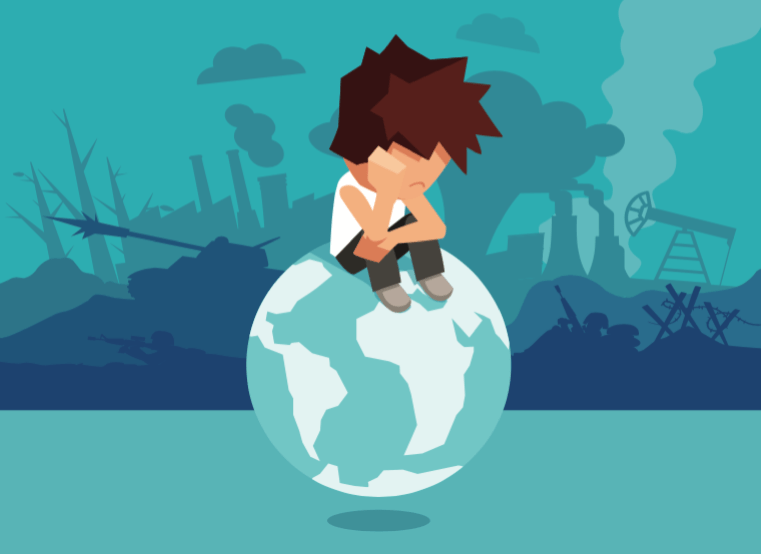
Climate change’s connection to anxiety and depression
By Sandi Schwartz
Hurricanes, tornadoes, floods, fires, droughts, rising sea levels. These are not topics for the faint of heart. But the reality today is that these types of natural disasters are on the rise due to climate change, and more people are being impacted as our population booms, especially in coastal areas. We can’t necessarily hide this news from our children. They will learn about climate change in science class, on television, and at museums—as they should. They also absorb the adult conversations going on around them, so when a major event hits like hurricane Harvey in Texas, our kids will hear about it.
As these disasters become more frequent due to the warming climate, mental health becomes one of the critical concerns that we need to pay attention to. Of course, those directly impacted will suffer most dramatically. Following Hurricane Katrina, nearly half of those impacted by the storm developed an anxiety or mood disorder and one in six developed post-traumatic stress disorder.
But when these events occur, we all suffer in a broader sense. What if it happens to us? Susan Clayton, professor of psychology at Wooster University in the UK, assesses that natural disasters significantly impact the mental health of millions of people. She sees three types of disasters that people worry about: the natural disasters themselves like floods and storms, slower changes such as an increasing global temperature, and the destruction of communities that can result. All of these can cause stress, anxiety, and depression as we try to either envision ourselves in a particular situation or adapt to the changes as they occur.
With all of these impending disasters looming as temperatures continue to skyrocket (15 of the 16 hottest years on record have occurred since 2001), it is no surprise that more and more people are developing eco-anxiety. This is a relatively new psychological condition in which a person experiences chronic fear of environmental destruction.
Children are particularly at risk for heightened anxiety and depression from a natural disaster. The American Public Health Association is working hard to study and educate people about the impacts of climate change on mental health. According to this organization, up to 45 percent of children suffer depression after a natural disaster. Some of the behavioral and psychological changes in children include an inability to speak, bed-wetting, stress or fright when not in danger, and self-harm.
For children who are just learning about these events, they worry that something bad could also happen to them. They have active imaginations and want to always feel safe. Climate change can instigate feelings of vulnerability and powerlessness that take the shape of anxiety. Surveys indicate that not only is global warming on our children’s minds, it is scaring them. One report found that approximately half of the children surveyed, ages 7 to 11, were anxious about climate change and often lost sleep over it. Another study showed that children ages 11 to 14 were more concerned about climate change than they were about their homework. Wow!
What You Can Do To Ease Your Child’s Fears
It is never a good idea to shelter our children from the world because when they do learn what is really going on, they will most likely struggle even more so. However, there are some ways to handle the climate change and natural disaster topics carefully so that our children do not form a major case of eco-anxiety before they graduate from elementary school.
Have an informative, well thought out discussion with them about climate change and its potential effects. Ask them what they already know and how they feel about it. Explaining that climate change is a long process and we have some time to fix the problem can be reassuring to children. Point out positive examples of how scientists and others are finding solutions like electric cars and solar panels.
Make learning about climate change and weather fun for your kids. Look for creative kid-friendly resources to teach about climate change on a level that they will grasp. Read books, attend science education events, and visit museum exhibits to learn more. Do your own experiments at home and encourage them to choose science projects for school related to solving climate change.
Show your children that they can play a role in helping the planet by working together as a family to reduce your family’s carbon footprint. Some ideas include replacing incandescent light bulbs with fluorescent or LED bulbs, turning of lights and other electronics when you are no longer using them, eating less meat, and carpooling to school and extracurricular events. Just be sure to instill the message that the goal is not perfection; they should do what they can and not stress about it.
Spend time outdoors appreciating and enjoying everything nature has to offer. A growing number of studies from around the world show that spending time in nature can lift mood and improve mental health. So, when you participate in activities like hiking, biking, camping, boating, and swimming, you are essentially combating your child’s anxiety or depression with a boost of green therapy.
Support environmental organizations by volunteering or sending donations as a family. Consider a donation in lieu of a child’s holiday or birthday gift. Empower your kids by letting them choose which organizations to help.
Avoid watching excessive television coverage of extreme weather events. The dramatic, intense images of tornadoes, flooding, and other harsh weather associated with climate change can be petrifying to children. Seeing images of people bleeding or crying could definitely cause nightmares for anyone.
Reassure and comfort your children everyday so they feel loved and protected no matter what challenges they face. Build a strong relationship in which they can talk to you about their fears so that they will ultimately be more resilient.





